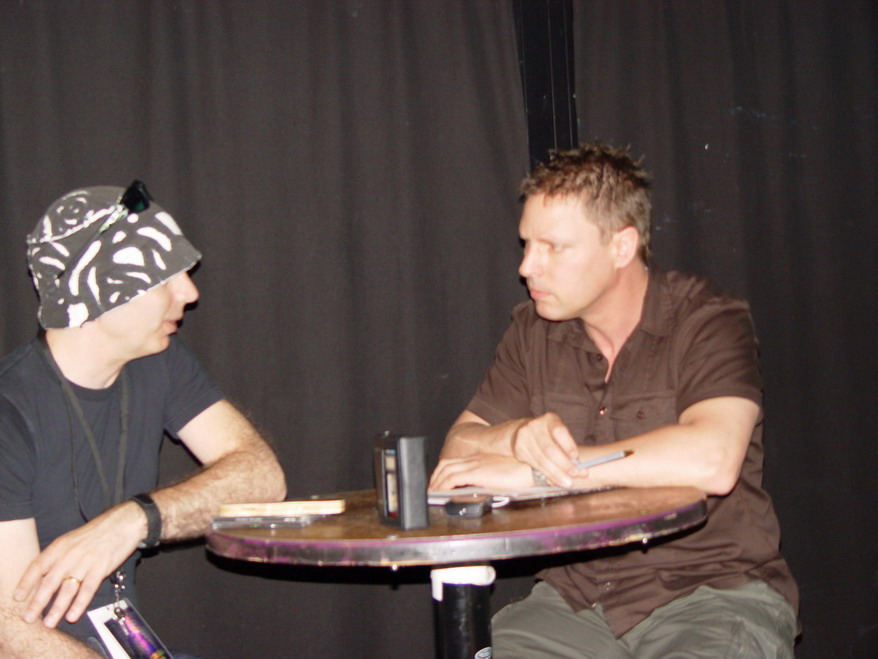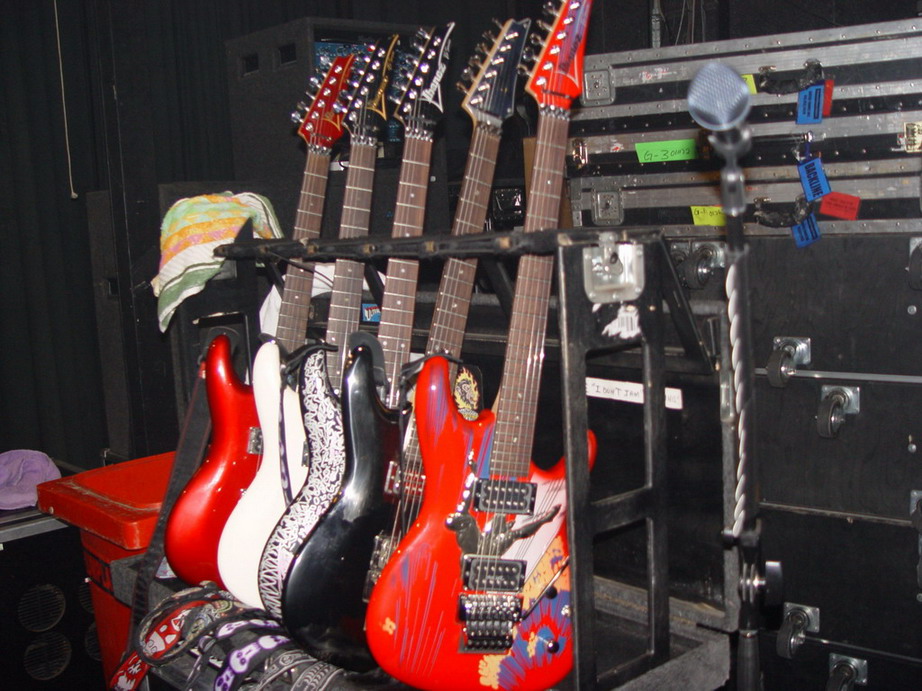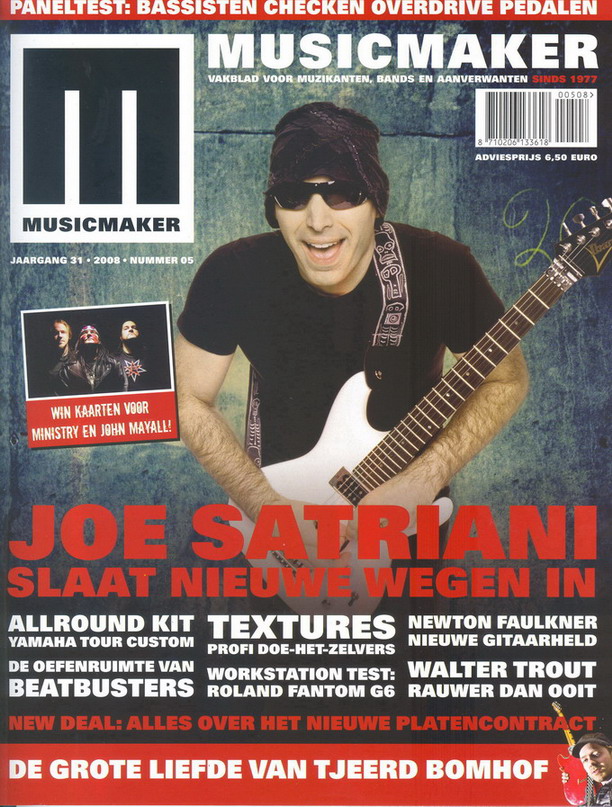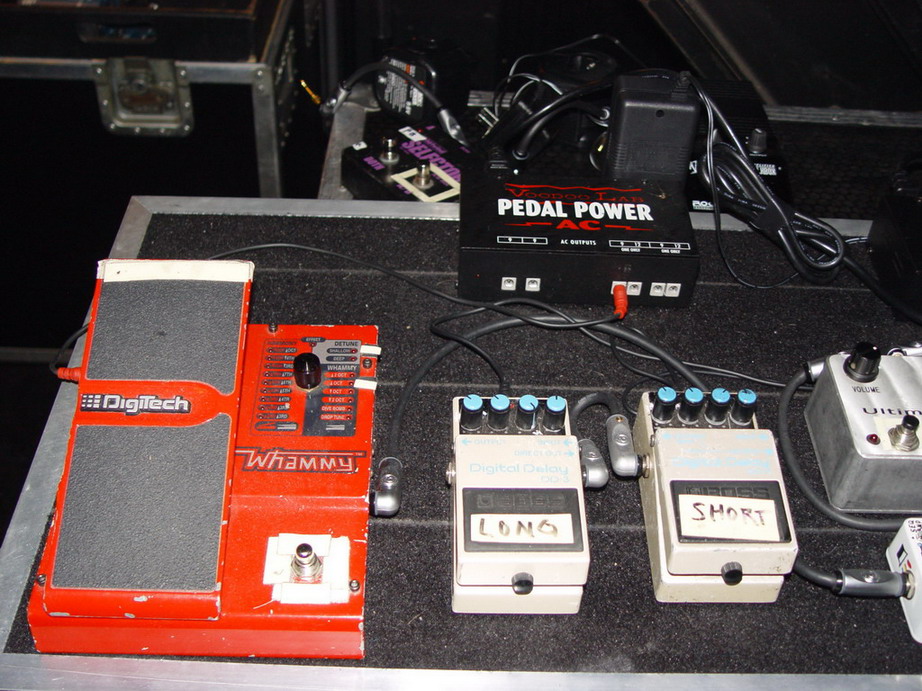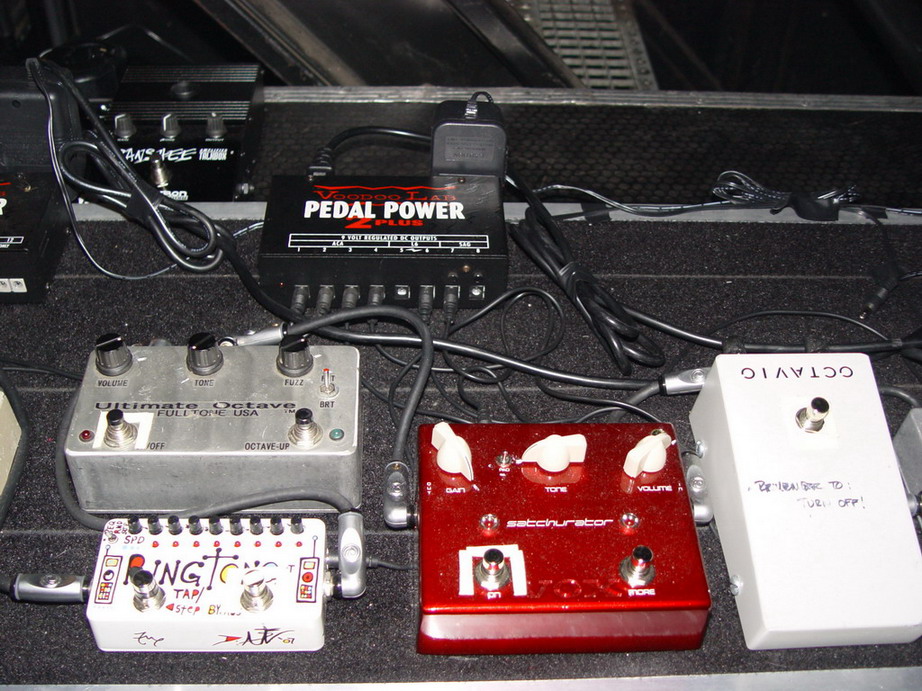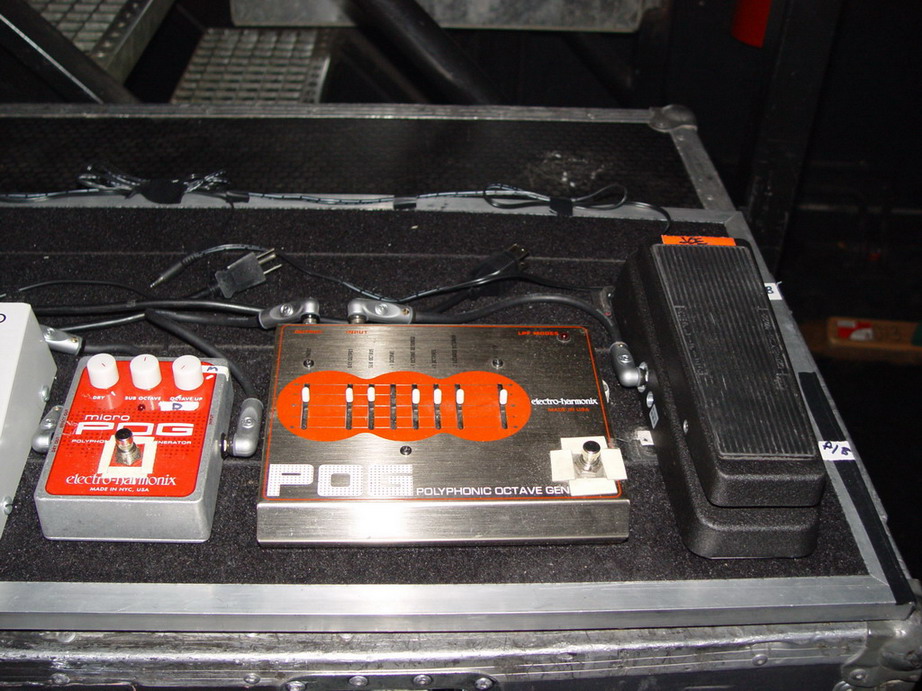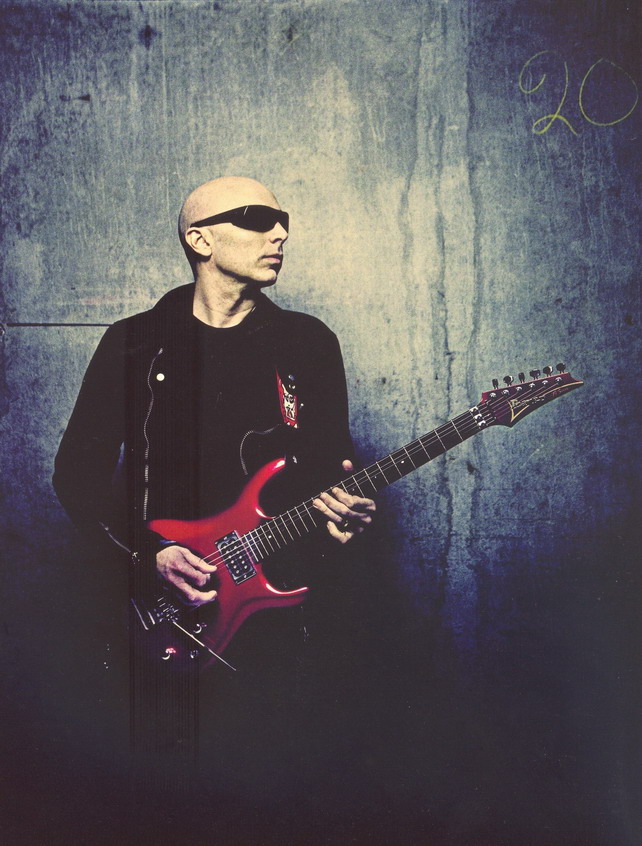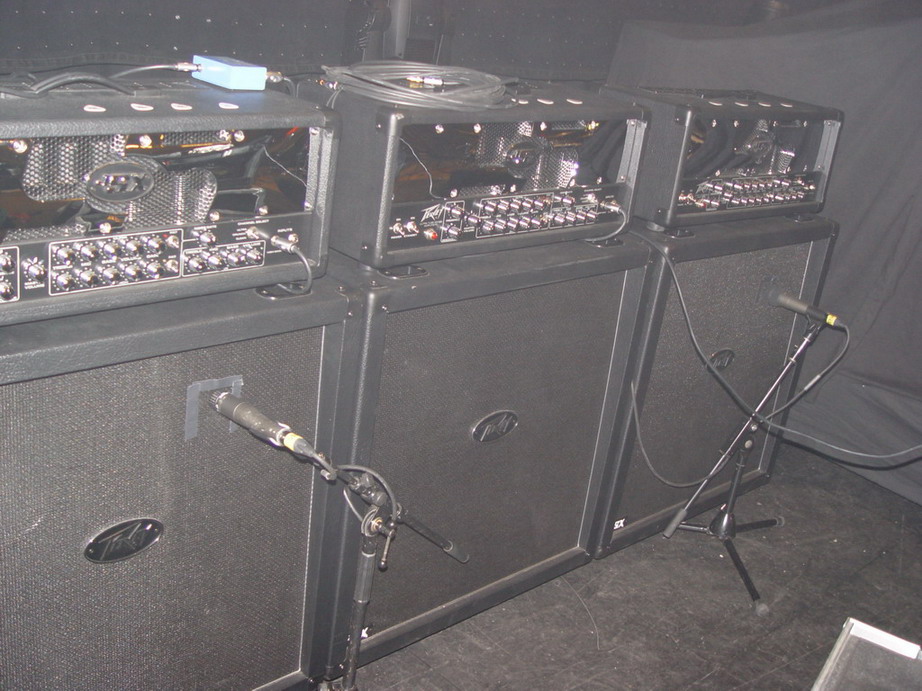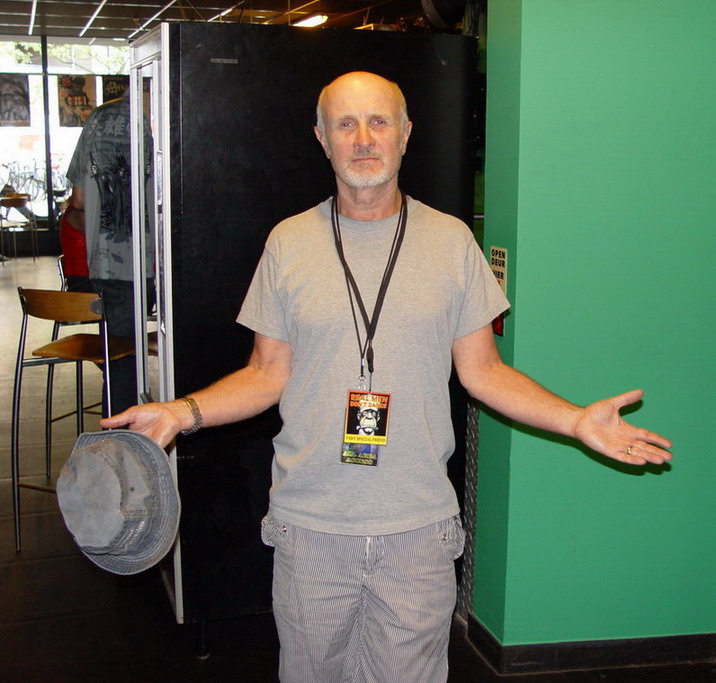Joe was in the middle of an European tour and I got the chance to sit down with him at the 013 venue in Tilburg. A friendly and inspired Joe spoke about his new album, inspiration for his tones and his new pedals.
This conversation took place may 10, 2008. A shorter version of this interview was printed in the Music Maker june 2008 issue.
Copyright Richard Hallebeek and Music Maker 2008. Copying or use elsewhere striclty prohibited.
:: Your new album ‘Professor Satchafunkilus’ has a lot of variation.
‘I think when I started out, I wasn’t quite sure where it was gonna go. And.. the usual process is, I write a lot of music, maybe 30 or 40 pieces. And then, a few months before the recording, I start to edit down. And I like to get it down to about anywhere between 16 or 20 before I start bringing in a co-producer, engineer, I bring over Jeff of whoever else in the band is in town. Because I live in San Francisco.’
:: Yeah.
‘And then I get their feedback. There might be some songs they don’t like that I decide to put off maybe until another record. And then we concentrate on those fifteen and each time around I guess they were very eclective, I mean we had some unusual arrangements that we hadn’t really done before as a team. And some of the songs had some similar textures or arrangements that were on other records. And so I think altogether the album turned into sort of a .. that had it’s own quirky mix that had it’s own identity, you know. Of course, that’s what you hope for.’
:: On ‘Andalusia’ you play acoustic guitar in a way I haven’t heard you do before.
‘Yeah. We spent you know.. Spain has become a touring country for us, whereas before we’d go there and play one or two shows and now.. we could probably spend a month there just touring all over Spain. And we have a wonderful time there, the promoters..’
:: I saw some pictures on your website from some huge stadiums you played there.
‘Yeah. We’ve done beautiful halls and stadiums and they have.. a lot of the small towns have beautiful concert halls that towns have put together for classical performances and opera and all sorts of things and so.. and now they’re bringing in rock and roll bands, because we’re an instrumental act we get to play these beautiful places, which is great, so..’
:: You got quite an audience there I guess.
‘It’s great. The Spanish fans are very nice fans, are very passionate and yet they listen.. they like to listen to the details, so,yeah, it was after that we spent a lot of time in southern Spain last summer and we wound up in Istanbul. So those two songs, Asik Veysel and Andalusie were actually one long fifteen-minute song. But I broke it up because I just thought I’d drive my audience crazy with all that guitar player for fifteen minutes! (laughter)I’d thought I’d separate them and give them a moment.’
:: I enjoyed hearing you play a lot of very loose-sounding extended solos on this album. Sounds like you took some chances.
‘Yeah. I don’t think I’d ever really done that on a record. And even with a song called ‘Searching’ a few records ago, I was kind of.. taking it easy you know what I mean. I didn’t went too crazy with it. But yeah, certainly with Andalusia it’s completely crazy, you know. And the energy level from the beginning to the end is just right at the top.’
:: What’s that scale in Musterion? The Hungarian scale?
‘That’s the Hungarian minor scale, yeah. I didn’t start out thinking about it. I was actually just playing the piano and I started playing these two chords and I just really fell in love with it and I started playing melody and then I wrote the chorus section and then I wrote it down on a little piece of paper and I forgot about it. And then when I started compiling notes, I had manuscripts and napkins and little pieces of paper and.. one day I looked at it and I went..ooh.. that’s very interesting! (laughs)And then I wrote the solo section, which is the four different minor keys, they go down, they descent. It’s a very unusual song. It breaks a lot of arrangement rules.’
:: There’s some really cool notes in the melody which is like a nice new taste.
‘Yeah, the sound of the guitar is very.. it’s rather unstable sounding. It’s still a hard one to play live because the guitar has a bit of a noise.. sound to it. Every night it’s different.’
:: One of my favorite songs on the album is ‘Revelation’.
‘Oh, thank you.’
:: I like that odd meter part in the B-section. It’s like a 9/4 going to 5/4 or something?
‘It’s a very.. I think everyone who plays it, depending on their part, thinks of it a different way. And it is really a very long 14/4.’
:: OK!
‘You know, that’s the way I thought. But that’s because I came up with a drum part for it, which was very simple. I played right to it. And at one point I had it.. I had it at 15/4 and I wrote the song at 15/4 and then.. I started not to like it and I took one beat off and suddenly I felt that the melody benefitted from that. So.. I took that one beat away and..but the hard part was the rhythm which was unusual because I play those particular arpeggios. To play those arpeggios and to sing the melody was very difficult. It was so syncopated that I felt uncoordinated. It took me quite a long time to do that. And the reason why I do it is to prove to myself that it’s a good melody. If I can’t sing it, then it’s like a movie score or something. It’s just music. But to be a really good melody you have to be able to sing it independent of whatever else is going on. So once I got to that point, I thought OK, now I have to learn how to play the melody and you know, with the right feeling. It was a lot of fun working on that song.’
:: Speaking of your songs, you wrote so many songs and told many times that you are composing all the time. How do you keep track of your ideas? Write them on napkins like you just mentioned, or…?
‘Whatever it takes. If I’m near a.. if all I have is a phone, I use the phone. You know, make a message.’
:: How do you do it on a tour like this?
‘On tour I have manuscript paper. But you know, we all have computers around us all the time, so I’ll use Quicktime Pro. I use a Mac and Quicktime Pro is a great way of doing it, because you can actually edit it and then you can actually play to it, and record yourself..you can actually do a crude sound-on-sound thing. If you need to have rhythm and then a melody. And.. they’re very small files. You can get a great song idea at 1 MB, it’s done. And that can be enough.’
:: You got a small home studio together, right? But nothing huge.
‘No, it’s just a small room, I mean, half the size of this room you know.. I’m gonna guess it’s 12 x 10 maybe? A very small room.’
:: Do you record direct with a Palmer of do you have an iso-cab with a mike?
‘Either the Palmer, the Marshall SE-100 (that’s an attenuator and speaker emulator-Rich)or The Transducer made by a company called SPL. I think they’re a German company, SPL. And.. I didn’t use it that much, that came later in the project. I think and old Marshall SE-100 that I found on Ebay was the one that got most usage. And you know, they’re all kind of funky. And some of them like Marshall amps and some of them like Fender amps, you know (laughs). So every once in while you come up with a sound on your amp that you like, but the Palmer doesn’t like it so I switch over to the Marshall or..I don’t know which was which but I know we used both of them during the course of the album.. all three of them. You know what I use, I have an HD-2 Pro Tools system running a Mac.. and I bypass patch bay, I go directly into my amp, into the speaker simulator directly into Pro Tools. And I’ve got great outboard gear, but I’m generally very conservative when I record at home. So that when I go into a big studio, the sound is flat you know, as we call it. There is an unusual equalization bump because I was in a little room in my house, so.. And then, some songs..around 85% of the guitars, all of the keyboards, are all done at my home. And then, some songs like ‘Andalusia’ I did the guitars again. The electric guitar. But we kept all the pianos, the bass was done at home.’
:: What made you decide to do some parts at home or some parts at a bigger studio?
‘I think some of it is because having the privacy to reflect is important sometimes. You know, when you’re in the studio, there is a time problem. It costs thousands of dollars a day and people there.. people only show up if they’re being paid. And then you.. it starts to worry you. And when you have a studio at home you can record at any time, right? Right after you wake up in the morning, before you go to sleep, in the middle of the night, you know. And that means you can really forget about your career of music and so and you can concentrate solely on the music.’
:: Some people tend to overdo their studio work by repeating and repeating until things are dead. Do you ever feel that danger coming up?
‘Well, I think all of us can develop that problem. I tend to record with friends so friends usually are brutally honest (laughs)’
:: They tell you when it’s enough.
‘Yeah, that helps, but you know, it’s a good point that you bring up and there are several performances on the album that are the first take. You mentioned revelation and that’s the first take. I wasn’t quite sure how it was gonna go, I don’t think I used the best amplifier sound, but it was the one that was the first one that I used. And so that.. I think added to it. Because I thought, well, this song has a very solid arrangement. The drums and the bass aren’t gonna do anything to outrageous, so I think if the guitar was a little.. if it’s a little outta control, it will be good. And also, when I would bring these recordings to my co-producer, John Cuniberti would say, I love that, we should leave that alone, or: let’s do this all over again.’
:: Was anything fixed tone-wise in the studio?
‘If anything needed to be fixed, to match up with Jeff’s performance or Matt’s performance, you do whatever you want, but you can also decide not to do. And I think that’s also a quality that you can develop by having very talented editors. So Eric Caudieux, who’s been editing my records ever since ’96 I guess since the first G3. He’s that kind of a guy, he knows that there is real beauty and energy in frantic, you know, ‘wrong’ performances. And that’s not the stuff that you look to fix, you know. Editing is supposed to be about maximizing good performances, it’s not about retuning and retiming you know. Then you should just play it again. That’s generally what we do and all of us in the band have grown up in the era of recording on tape, so we know what it’s like to lose performances of one little mistake. And then you do them over and over again ’till you get it right and then all the live is out of it. With Pro Tools you don’t have that danger anymore. You know, you can fix that one little part. Which is really great for the audience, because they do get to hear the most inspired performance. We just try to remember that, you know. If there’s something that’s good, we don’t care where it was recorded. Because we can make it as loud as it has to be or as quiet. We can re-equalize it to fit the new drumsound.’
:: Your tone has been very special over the years, it’s unlike anything else. Some of it can be easily tracked to Jimi Hendrix, but then it’s also so much more and different. Where is it from?
‘(laughs ) You know, there is something about it, when I think about it..’
:: And it’s not heavy metal at all.
‘No, it’s definitely not. You know, one of the issues that I realized, I fell into doing the instrumentals by accident, I was always just the guitarist in a rockband. And in ’88 when Flying.. when I was on tour, starting out, a three week tour really, for Surfing With The Alien that was the first time I’d ever been a solo artist and I really didn’t know..’
:: I heard the recordings of that tour at the time, that was awesome high energy.
‘Yeah. But I didn’t know what to do, walk out on stage, not singing and just play for people. And I also did not know what to do with my equipment, exactly how it was gonna get through this gig. Because for years, decades , I was always playing rhythm. And then I’d play solo for about eight bars and then go back to playing rhythm. And this gig that I do now is very different. It needs different sounding equipment to be able to go melody-solo-melody, melody-solo, song after song after song two hours every night. The strangest job ever. So right about that time that ‘Flying In A Blue Dream’, it was after that one tour, I toured on my own and I toured with Mick Jagger and I got this big (pauses) lesson in live performance in twelve months. It was like going to school. And I came out and I was, wow, that was very interesting. Everything changed, all the gear I used, everything was different. And all the stuff I thought that would work didn’t work at all. And so when we went into doing Flying In Blue Dream we had a more refined thing, ’cause by then myself and John and Jeff, we had done this is our third record. And so.. we felt confident that when we did ‘Flying In A Blue Dream’ with that signature tone, we could get it in the simplest of ways. Just the guitar, a very old Boss DS-1 we had I think at the time I think a Boogie, but it was just a clean tube amp.’
:: Did you also use the BBE maximize there?
‘No, we used that one on the Surfing record. Yeah. But by then, the sound of music had changed. I mean, the surfing record it’s not.. there’s not a whole lot of low end. It was before subwoofers and.. cd’s were still very.. everyone was skeptical about it. ‘Flying In A Blue Dream’, we mastered that directly to metal. So we skipped the laid-on-vinyl process. And so the album itself and we were still making albums back then, the album itself had a very special low end to it and the dynamic range was better because of the process. But then after that, we went into cd-land and everything changed. It was a very interesting process. It’s during trial and error that.. you develop a sound and you don’t really know it until somebody tells you. ‘
:: It has some classic rock, some jazz-rock, something else..
‘Well, I’m the product of all of that I guess. What it is, yeah.. all those influences.’
:: But of course we can get all of that and even more with your new Vox Satchurator Pedal!
‘Yeah! (laughter) I’m still working on.. having fun with it live and just today, we just did a Club Joe (the thing were people can buy special tickets, get in during soundcheck and ask questions, make pics etc. -Rich) and there were a lot of technical questions there. And today we had this one thing that we were working on for the last week, we were doing a song called ‘Crying’. And you know, the original recording of ‘Crying’ was so unusual because my guitar performance was recorded by accident. We were recording and really trying to get the drums and the bass, that particular day. And I recorded a keyboard part and it was sequenced. So that the Bisonette brothers were recording against this sequenced keyboard and they decided, Joe, why don’t you play guitar just so we can kinda know where the song’s going. So.. I used a little Zoom box, you know. Just because we thought we were just gonna listen to it, we were’nt gonna record it. And we finished the take and Andy Johns turned around and said ‘Oh my god, you just did the performance.’ He said I’m so sorry, what were you playing through?’
:: Wow, so that was just a Zoom?
‘Yeah, yeah. Because, you know, you never know when you’re gonna do that take. I could have.. and you know we thought months after we were working on it, we kept saying, you know, the professional side of our brain would say, you can’t use a Zoom. So we tried to record it, but we couldn’t get back to that emotional moment. And so we realized, we’re just gonna use the Zoom, we just gotta figure out how to make it work! (laughs)‘
:: Interesting.
‘Yeah! So this afternoon we were doing a soundcheck and we’ve been playing this song ‘Crying’ live, which poses a very difficult problem. You’re onstage, you’re loud, the guitar actually has a sound with a lot of gain on it. But with it, loud and gain, comes noise. And also feedback that you may not want. And years ago, on tour, it was always how to get my guitar volume up loud enough without feeding back, so that I could play delicate things.’
:: But your Peavey amp has a noise gate, right?
‘No, I don’t use the noise gate. The good thing about the Satchurator is that, today I just took the gain knob and I brought it down and the unique way that we sort of rearranged other distortion boxes, you know, built with success in the past, is that..the problem with other ones is that it they’re not on 10, they don’t give you sustain. But very often when they’re on 10, they give you a lot of cheesy, brittle stuff. Always been a problem with boxes, so.. with a lot of trial and error we solved that problem, so I’m able to run the box at.. And not have to have it on 10 and I got this beautiful sustain for the song ‘Crying’ and yet there’s no feedback which means I can walk anywhere on the stage, so. It’s been great to have that finally on tour. I mean, I had it last summer, the prototype, had used it on the album, but to play it, venue after venue, indoor, outdoor, big, small, you know.. hollow stage, solid stage, it’s great to really see how it works.. in real life, you know.’
:: Did I see a prototype pedal in one of your pedalboards, a chorus?
‘I don’t think so, I’m not using a chorus tonight.’
:: It was on a picture, guess from the American tour.
‘It may have been a delay. We haven’t done a chorus yet.’
:: What’s your next pedal for Vox?
‘We have a wah-wah and a delay that are very close to being finished.’
:: What’s new about it?
‘Well, the wah-wah is a very multi-functional wah-wah. It finally combines some elements that all wah-wah’s lack.’
:: I think you know your wah’s.
‘Yeah! (laughs) And what I’ve noticed is that live, I’m using more modern components and in the studio very often I’m using vintage components, as well, as that the wah-wah’s react differently to those two different worlds of amps. Mainly because the vintage amps do not have gain inside of them. You have to drive the input, right?’
:: Right, use a booster.
‘Right. And they also usually have a warmer midrange to them and the low end is more complete. And then you go to a modern amp and it’s got a lot of gain and generally they get that gain by over.. by sort of clipping in the midrange area. You put a wah-wah in front and you get double clipping. And all of a sudden, instead of it becoming bigger, your amp sounds smaller. And.. so what they started to do, they would development wah-wah’s that sounded good, like when you were plugging into a dual rectifier and you had it all the way cranked up. But if you take that same wah-wah and you put it into your Fender Deluxe reverb, it sounds horrible. Sounds like a goofy electronic box, it doesn’t sound like Eric Clapton’s wah-wah, you know. So, my request to Vox was please, finally, have those two worlds co-existing in one pedal. So that the working guitar player can just have that one pedal. And if they’re playing at let’s say, at a wedding, or something where they gotta play a lotta songs, for a few hours and they need to sound like Zakk Wylde, or they need to sound like Joe Satriani or they need to sound like Eric Clapton, then all they have to do is just turn a knob here and there and then they have it.’
:: That would be great. What about the delay? There’s so many already, what’s special about it?
‘Well, two things for the delay is that I’d like to bridge the gap between the tape delay and the electronic delay. I understand that the digital delay is a really great thing for stability. It uses less energy, it’s very dependable and the least amount of functions on it is usually the best. But then of course the sound.. that thing that people call vintage quality is really a degredation of sound, it’s really a malfunction of the unit that creates that interesting sound people like. In other words, the old echoplexes would not.. the capstan wouldn’t turn properly and you’d get a warble. You’d get a warble on the tape. And of course the tape looping around as it would get older you’d lose high end and it would get darker. So, I’ve been trying to simulate a little bit of the warble and a little bit of that EQ so that, just at the flick of a switch, you can get the functionality of a digital delay but the tone of an older unit and have the variation of that in one box. Plus a little extra but I won’t go into that.. yet. (laughs)‘
:: Wow, looking forward to checking those new pedals. You have made quite a few albums and when I look at your schedule it looks pretty intense sometimes with almost a new album every year, touring..is there pressure, or how hard is it to be Joe sometimes?
‘No, it’s not. I gotta say, I’m very fortunate. I’m doing my own thing, I never thought, ever, I would be so lucky and the fans have given me a career, you know. I don’t complain about one day, I don’t care if it’s a horrible hotel room, a bad day of travelling..’
:: Don’t you ever feel pressure you have to come up with something, another album?
‘No, the hard thing is just travelling without my family, that’s the hardest thing. But we don’t do that that often. This one of the few tours where I don’t have my wife and my son with me. But other than that, it’s fine. I tell people, it’s not a real job (laughs) So it’s great to be able to devote yourself to creative pursuit all the time. I look forward to it every day.’
:: What are you doing ten years from now?
‘(laughs) Well, hopefully I’m still playing. That’ll be great. Maybe with a more relaxed schedule. (laughs) That’ll be good. Hopefully there’s music to work on and people to play with and maybe some more products to develop. I wish there was time to work on.. you know, making films and engineering you know, a good band. I do like that.’
